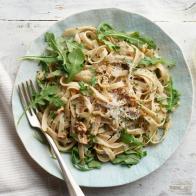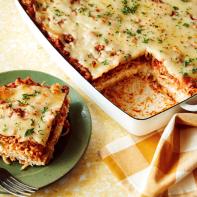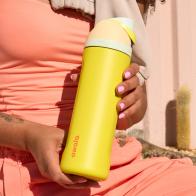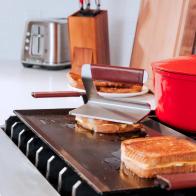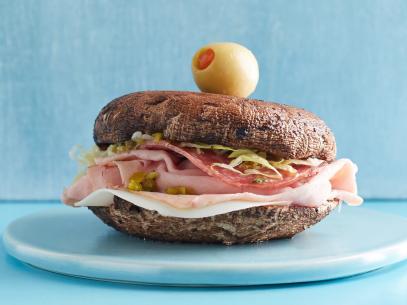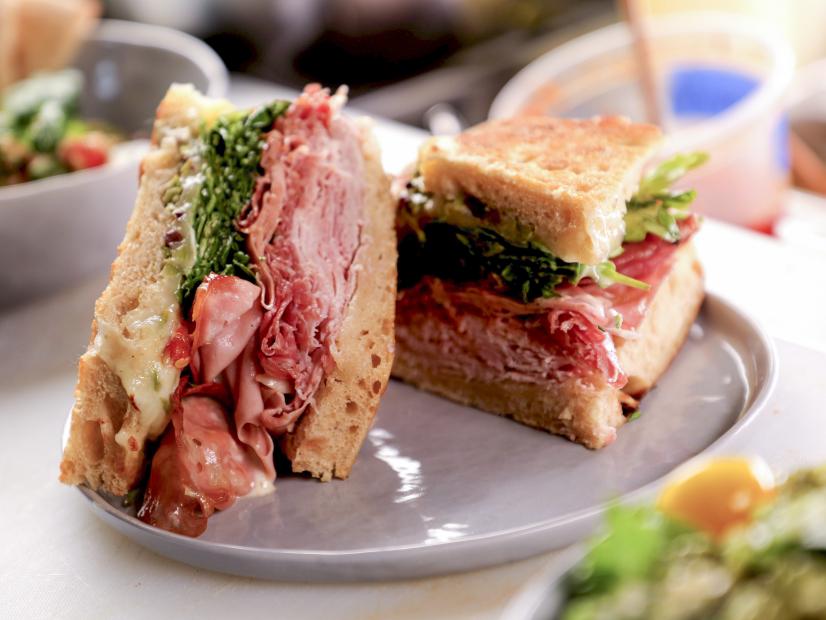
Italian Sandwich
- Level: Advanced
- Total: 2 days (includes fermenting, rising and cooling time)
- Active: 1 hr 55 min
- Yield: 4 servings
- Level: Advanced
- Total: 2 days (includes fermenting, rising and cooling time)
- Active: 1 hr 55 min
- Yield: 4 servings
Ingredients
Levain:
Focaccia Dough:
Giardiniera:
Calabrian Honey:
Slow Roasted Tomatoes:
Aioli:
Sandwich:
Directions
Special equipment:
3 quart-size mason jars- For the levain: I like to start this process in the afternoon and bake my loaf first thing in the morning. It does seem like a long process, but the actual work time is very little. It just requires you to be present. I am able to prepare other items while making the bread, and even take a power nap. Always use a scale when making bread for best accurate results.
- Start by taking a mature starter that has been kept alive on a regular feeding schedule and add to a clean quart-size mason jar. Create the levain by adding the warm water and bread flour. Mix with a spoon until all the dry flour has been mixed well. Store the jar, covered, in a spot in the kitchen that has a slightly warm ambient temperature (around 80 degrees F) until the levain has grown by at least double, about 2 hours. Check to make sure that a small amount of the levain (about a tablespoon) will float in water (the float test). If the mixture floats, you are ready to start the bread making process.
- For the focaccia dough: Fill a larger mixing bowl with 700 grams warm water, then add 200 grams of the levain mixture. Add the sugar and yeast to the water mixture. Gently mix by hand to break up the starter and dissolve the yeast. Let stand for 5 minutes.
- Add the bread flour and whole wheat flour to the liquid mixture and mix thoroughly by hand, using a dough scraper to keep bowl sides clean. Make sure there are no dry bits remaining. Cover the bowl and let stand for 30 minutes.
- Add the remaining 100 grams warm water and the salt. Mix by squeezing the dough until the salt and water have been absorbed. Use a dough scraper to make sure the bottom of the bowl is clean and the dough mixture is well mixed. Cover and let sit for 30 minutes.
- Uncover the bowl and perform 4 folds of the dough: Grab the dough edge farthest away with your hand and stretch upward and fold the dough toward yourself on itself. Rotate the bowl 90 degrees and perform the same motion. Do this same motion until you have folded the dough a total of 4 times. Let sit 20 minutes, then repeat. Continue to repeat until you have performed 6 cycles of folds every 20 minutes, up to 2 hours.
- Place the dough in a sealed rectangular container that will allow for dough expansion. (The container should be about 3 times the size of the dough.) Refrigerate the dough for 8 to 12 hours before the final shaping.
- Dust your work bench with flour. Dump the dough out of the bowl onto the workbench. Stretch the dough out gently into a larger rectangle shape. Fold the right side into the middle, then the left side to cover the middle crease. Fold the front side into the middle and then fold the bottom forward completely, rolling the dough so all of the creases are face down. Using both of your hands with a small amount of flour on your hands, shape the dough into a nice round ball so all the creases are tucked under the dough.
- Oil a half sheet pan with olive oil. Place the ball of dough in the middle of the pan. Make a mixture of 2 cups water and 1/4 cup olive oil in a small bowl to wet your hands and pat the top of dough to cover so a skin does not form on the dough. Let stand on an oiled pan in a slightly warm area of the kitchen (80 degrees F) for 30 minutes.
- Turn the oven on convection to a temperature of 425 degrees F.
- Every 15 minutes, wet your hands with the water/oil mixture and push down on the dough outward towards the edge of the pan using your fingertips to leave an indentation. Once the dough has been stretched out to the edges of the pan, sprinkle the dough with large flake sea salt.
- Bake for around 15 minutes, then rotate. Continue baking until the focaccia is lightly golden in color, 10 to 15 minutes. Remove from the oven and rest the focaccia on a cooling rack until fully cooled. Using a bread knife, portion into 6 to 8 individual pieces.
- For the giardiniera: I like to grab my produce from the farmers market when available. This is a great condiment to have on hand to top pizzas, add to salads, or any other sandwich. This recipe can easily be cut in half for this sandwich, but I promise you will want to have this around.
- Place the celery, carrots, peppers, cauliflower and onion in a mixing bowl. Sprinkle the sea salt over the vegetables, then cover with cold water so that all the vegetables are submerged. Cover the bowl and let sit for 24 hours.
- Strain the vegetables in a colander, then rinse vegetables thoroughly. Move the vegetables back to the mixing bowl and add the olive oil, garlic, zaatar and peppercorns. Mix with your hands. In two sanitized quart-size mason jars, pack the vegetables tightly (see note). Really press them down.
- In a blender, combine the white vinegar and sunflower oil. Blend until the ingredients emulsify temporarily together. Pour over the vegetables until completely covered. Refrigerate.
- For the Calabrian honey: In a food processor, combine the Calabrian chiles and honey. Mix until well combined.
- For the roasted tomatoes: Preheat the oven to 450 degrees F.
- In a mixing bowl, mix together the tomatoes, oil, vinegar, garlic, parsley and shallot and place on a baking sheet. Bake for 10 minutes, then turn the oven down as low as possible. Continue to roast until the tomatoes look slightly dehydrated, 1 1/2 to 2 hours. Let cool and refrigerate.
- For the aioli: The key thing to remember is the temperature of the mixture while using a blender to emulsify. You want to perform this task semi-quickly, so as to not let the mixture heat up too quickly from the blender. Drizzle your mixture slightly and not too quickly. The blender needs to work fast enough to allow for emulsifying to happen. Drizzling the oil too quickly will cause the mixture to break and not thicken. I find that the blender works best, but an immersion blender can be used as well.
- Start by adding the eggs and honey to the bottom of a blender. Start the blender on a lower speed, mixing the ingredients. Immediately start to drizzle the sunflower oil into the mixing blender through the hole of the blender top, watching to ensure that you are not drizzling too fast. Begin to speed up the blender until high mode as you drizzle the oil. Drizzle in some oil until the mixture becomes very thick. Stop the blender and add the vinegar, cold water and sea salt. Start the blender again on low and bring up to high speed fairly quickly. Add the remaining oil until the mixture is very thick again.
- For the sandwich: Preheat a convection oven to 450 degrees F.
- Slice the focaccia bread in half and assemble the mortadella, Italian ham and Genoa salami in small pillows on the bottom half of the sandwiches. On the top half of the bread, add the giardiniera and roasted tomatoes, then cover with the cheese. Place the sandwich sides on a baking sheet and bake until the cheese starts to slightly brown. Remove from the oven and place the two sandwich halves on a cutting board. Slightly dress and season the arugula with the oil and vinegar mixture. Place the arugula on top of the meat and drizzle with the Calabrian honey and aioli. Fold together the sandwiches, then cut in half and share with your favorite people.
